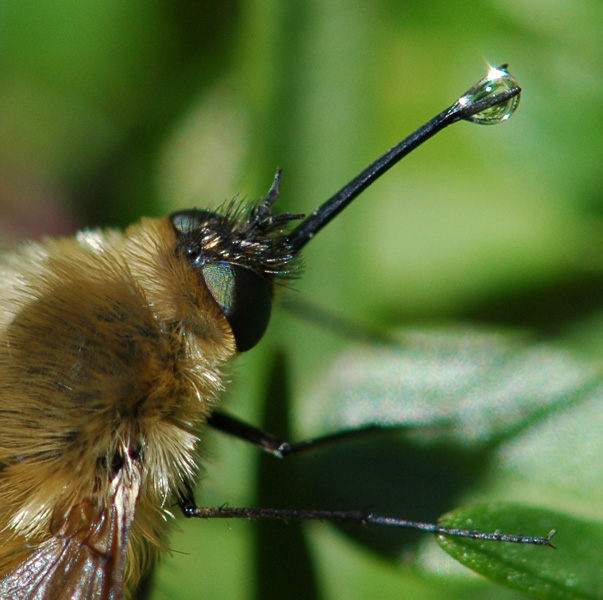 |
| Since many useful contributions have been made, but the topic is quiet now, I thought this might be the right moment to summarize all information. This is what I do in 1 ? 5. I then try to evaluate the various explanations put forward in 6 and 7. Finally, I suggest in 8 how we might continue to contribute to increasing knowledge about bubble blowing. I couldn?t resist bringing in some personal opinions, but these are always clearly mentioned as such. |
| 1. |
Many flies blow bubbles, but not all: syrphids seem not to be engaged in blowing bubbles. |
| 2. |
Other insects (bees, wasps, lace wings) do blow bubbles too, but not dragonflies. |
| 3. |
The phenomenon is apparently not sex-limited. |
| 4. |
Bubbles are either translucent or opaque. |
| 5. |
Functional significance ? if the behaviour has any ? as yet unknown, but there are some interesting suggestions: |
|
a. |
Bubble-blowing may play a role in digestion: |
|
i. |
Concentrating the fluid through evaporation: |
ii. |
Aerating the fluid so that microbial fauna would be affected to the detriment of obligatory ; |
iii. |
Heating up the fluid by exposure to sunshine. |
b. |
Bubble-blowing is a symptom of a common fly illness. |
c. |
Bubble blowing is a defensive move. Some insects use regurgitated food as a weapon. They try to spread the sticky, noxious liquid over the attacker. |
d. |
Flies do blow bubbles to clean their mouthparts with this fluid, more or less to flush them, and after they are ready they ingest the fluid again. |
e. |
Flies can use bubbling for cooling of overheated body ? thermoregulation.
|
| 6. |
Since we have to rely solely on observations, and not on experiments, the only way to proceed is to see whether the logical consequences of various hypotheses fit the observations. This has been done by many of the contributors to this topic, and I just will try to summarize the various points. |
a. |
This hypothesis seems to have gained most support in the 60+ posts so far; but not all sub-hypotheses seem equally relevant. |
i. |
This suggestion appeals to many contributors. Bees appear to do the same. My comment: Syrphid flies may also feed on pollen, which need not be concentrated. So the absence of bubble blowing in syrphids may be partly explained by their food choice. |
ii. |
Doubts have been expressed about the oxygenation idea, since many anaerobic bacteria may show oxygen tolerance ? they just don?t use it. |
iii. |
The heating up hypothesis seems to be discarded. Many flies bubble while not being exposed to the sun. Also, since the fly?s body is usually dark, in sun-exposed conditions stomach content should heat-up faster inside the fly than outside it. |
b. |
My comment: our runny nose is a passive reaction of our nasal mucus, whereas the flies seem to perform the behaviour at will, fully controlled. |
c. |
Because flies sit down while blowing, the behaviour makes them an easier target for predators. My comment: flies seem to blow frequently in the absence of any predator. Both observations apparently contradict this hypothesis. |
d. |
My comment: would a small number of bubbles not suffice? Often flies blow large numbers of consecutive bubbles. And why wouldn?t syrphid flies need to clean? Furthermore, the cleaning-suggestion was based on an observation of a Bombylius with a water droplets at the base of the proboscis. I here show a photograph of a bombyliid that is really bubble blowing like the other flies. |
e. |
My comment: this cannot explain the bubble blowing in non-exposed and cold conditions. Various observers mention bubble-blowing behaviour in conditions that would favour warmth seeking behaviour rather than the opposite.
| | 7. |
The strongest hypothesis would explain all observations of bubble blowing by a single function, and also explain the absence of the behaviour. The only hypotheses from above that may hope for this are a i & ii. The other hypotheses, a iii ? e, are not sufficiently powerful. They are either contradicted by various observations, or suffer from theoretical problems.
|
| 8. |
The question is, how to continue? Since none of us, I guess, is able to spend a few years experimenting on this phenomenon, however fascinating it may be, we?ll have to settle for additional observations. I think we can still gain a lot from such observations, if it is done with some rigor. This might help to narrow down the range of potentially viable hypotheses about a functional significance of the behaviour. In doing additional observations, I suggest to pay attention to the following (additions to this list are welcome!) |
a. |
First, it would be most useful to know the phylogenetic distribution of the behaviour: which flies do it, which not. Our current information is too scanty to draw any firm phylogenetic conclusion. Solid negative evidence is, of course, hard to come by ? yet it is highly relevant to be reasonably sure about the absence of the behaviour is particular groups. For instance, do syrphids indeed never blow bubbles? This calls for extensive observations: any single observation can be meaningful! |
b. |
Second, how is the behaviour related to feeding? Was any feeding behaviour prior to blowing observed? If so, what did the fly consume? What is the fly feeding on normally? Nectar, or decaying animal material? |
c. |
Third, when are bubbles transparent, when opaque? Is this related to the food source? Is it phylogenetically constrained? |
d. |
What are environmental conditions during the behaviour? Temperature, sunshine, humidity, wind may all be relevant. |

